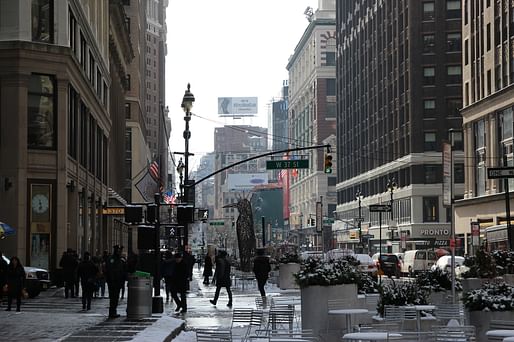

New York City officials announced plans on Thursday to ease the conversion of office buildings to housing and to open manufacturing areas south of Times Square to new residential development, as part of a broader push to reinvent the struggling business district in Midtown Manhattan and address the city’s housing crisis. — The New York Times
The news comes after the revelation last week that a total of zero new housing starts were approved in Manhattan in the month of July. The Adams administration previously announced its desire to create 40,000 new residential units through the adaptive reuse of office buildings. The rezoned area south of 40th Street to 23rd Street will be bordered by Fifth and Eighth Avenues, respectively, and includes the historic Garment District, Penn Station area, and parts of Chelsea.
They are part of a larger spate of zoning changes that coincide with the development plan, including the addition of structures built as recently as 1990 to the list of those now permittable for conversion schemes.
“The world has changed,” New York Mayor Eric Adams said at the announcement press conference. “We have to be willing to change with it.” He's not kidding. Median monthly rents in the borough are now estimated at $4,400, according to the New York Times.
A lot of those buildings are hard to convert. Have tried in Tokyo where the economics are comparable or maybe easier and we could not get the math to work more often than not.
That said, the added flexibility is a good thing because cities need housing. That the system is not equitable sucks, but having no new housing is even worse.
FWIW Japan has had a surplus of housing since the early 1970s (a policy choice made at the time that others did not copy). There is no housing crisis, and people can live in Tokyo in pretty much any neighborhood they like as a result. Housing is not the crazy commodity it has become in other parts of the world. That outcome starts with allowing more housing. In which case, cant help but see this as a positive.
All 4 Comments
Yeah? Erica Adams is still a corrupt pos, and this will only go to making the rich, richer.
corrupt incompetent* pos
Non-rich working people will very much be hurt by this plan as manufacturing facilities and jobs in Manhattan will be done away with in favor of expensive housing. Nothing is being done to address the root problems of landlord greed and the nutty, inflated property values that the owners of obsolete buildings are clinging to.
A lot of those buildings are hard to convert. Have tried in Tokyo where the economics are comparable or maybe easier and we could not get the math to work more often than not.
That said, the added flexibility is a good thing because cities need housing. That the system is not equitable sucks, but having no new housing is even worse.
FWIW Japan has had a surplus of housing since the early 1970s (a policy choice made at the time that others did not copy). There is no housing crisis, and people can live in Tokyo in pretty much any neighborhood they like as a result. Housing is not the crazy commodity it has become in other parts of the world. That outcome starts with allowing more housing. In which case, cant help but see this as a positive.
Great idea!
For those unaware, manufacturing has been gone from Manhattan since the 70s and blue collar workers have been the largest constituent of the hyper-commuter coalition for the past 20 years. I think it's a little hilarious that everyone is acting like office conversions are new...the loft conversion laws of the 70s/80s were the precursor. What is different is that unlike those projects, which occurred when cities were vacated because of blight and squatting and loft conversions became the way for those seeking larger open spaces to create live/work housing...our definitions of housing have narrowed (in some regards) and the ownership of the large portions of the city have narrowed to create a similar vacancy based over-housing of a small elite percentage of the population...which creates a reverse incentive where any form of housing made automatically migrates because of cost and availability to those who are already over-housed. So what is the root of the problem and how is that solved? How do we create more housing for people and not just for the small percentage that have multiple houses? The model thus far has been to incentivize developers to create this housing by giving them a tax rebate for a period of time if they built a percentage of "affordable" housing. The other model has been the Section 8 and 9 housing provided by the city, but that has it's own issues (see the Chelsea Housing debacle taking place). So housing is more than just buildings....even though buildings are a start of a solution...but where is the financial incentive structure and who is being tasked with the construction of it? I would suggest that the current financing and development model is large part of the issue.
I had not heard the term "overhoused" previously and I like it.
Block this user
Are you sure you want to block this user and hide all related comments throughout the site?
Archinect
This is your first comment on Archinect. Your comment will be visible once approved.